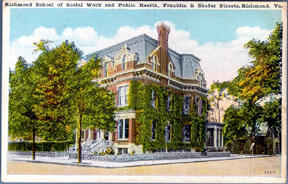July 12, 2005
VCU’s Monroe Park Campus marks 80th anniversary
Share this story

The starting point for Virginia Commonwealth University’s Monroe Park Campus can be found at the intersection of West Franklin and Shafer streets and the building known as Founder’s Hall.
Eighty years ago on July 1, 1925, the Richmond School of Social Work and Public Health bought the property at 827 W. Franklin St.
The Richmond School of Social Work and Public Health was launched in 1917 and had its beginnings on the third floor of a brick building, located at 1112 Capitol St., in Richmond. By 1925, the College of William and Mary had agreed to take over the school and maintain it provided it acquired a permanent building in a central neighborhood.
The site chosen was the Saunders-Willard House, located at the corner of West Franklin and Shafer streets. Built for a Richmond merchant between 1883 and 1885, the house had three stories, a basement and stable in the rear. Richmond’s business community responded to fundraising efforts and donations totaled $103,925. The house was purchased for $73,000 and another $23,000 was earmarked for repairs and alterations.
Henry H. Hibbs, Ph.D., director of the Richmond School of Social Work, established his office and the school’s general office on the first floor and turned the kitchen and several other rooms into classrooms. The second and third floors were used mainly as a dormitory for women.
Hibbs would demonstrate his ability to adapt old houses, stables and lofts to fit the academic, administrative and residential needs of his institution time and again and would do so even in challenging economic times.
From that point, what later became the Monroe Park campus would continue to grow. The Ginter mansion, built in 1888 by Major Lewis Ginter for about $225,000, was purchased for $85,000. A large brick stable on the property was turned into the A.A. Anderson Gallery of Art, and in 1928 it became the site of the School of the Arts. From 1938 to 1942, the school acquired a dozen additional properties on West Franklin Street, Park Avenue and Shafer Street – the total price for all of them was $115,000, although appraisals exceeded $288,000.
The school changed its name to Richmond Professional Institute in 1939.
Hibbs continued to grow his institution, writing later how enrollment had grown from 51 full-time students in 1925 to 450 in 1940 and 1,100 in 1952. The curriculum had been expanded to a dozen schools or divisions by 1953, when full accreditation came from the Southern Association of Colleges.
“None of these duplicated the work of other colleges in Virginia,” Hibbs wrote about the institute that grew from the two original schools. “All were different, and some were the first of the kind to be offered in the South.”
After 80 years, VCU’s Monroe Park campus has grown to include 93 buildings. It currently stretches from West Broad Street to West Cary Street and there are plans to add new land and new buildings as the new $200 million Monroe Park Annex is developed east of Belvidere Street, between Main and Canal streets.
Subscribe to VCU News
Subscribe to VCU News at newsletter.vcu.edu and receive a selection of stories, videos, photos, news clips and event listings in your inbox.





